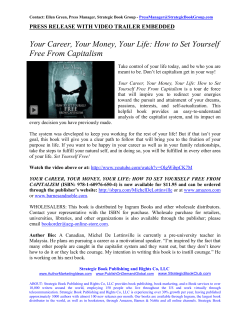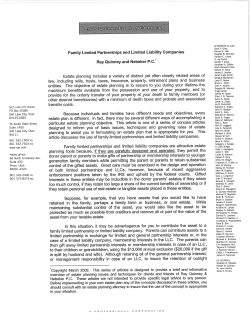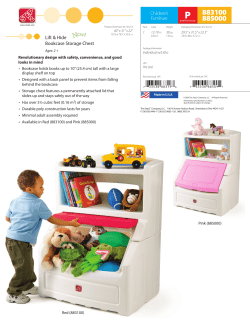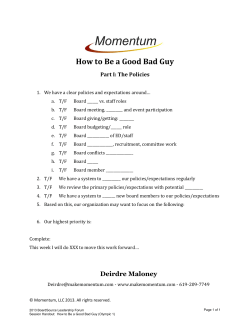
Learn How to Write Effective Appeal Letters When Your Claims
Learn How to Write Effective Appeal Letters When Your Claims Have Been Denied: Important Strategies for Revenue Cycle Integrity LaDonna Waugh, M.D., J.D., F.A.C.S. Director of Appeals Management Accretive Health, Inc. November 9, 2011 SLIDE 1 The Appeal Letter • • Appealing adverse decisions made by payors or private contractors on behalf of commercial payors, Medicaid, and Medicare is predicated primarily on effective written communication. This communication may be used in legal proceedings, and the appeals process should be considered a legal process. ©2011 RAC MONITOR LLC SLIDE 2 The Appeal Letter • Effective appeal letter writing is very important and if properly framed is one of the best tools in recovery of revenue for the hospital and in securing benefits for the beneficiary patient. ©2011 RAC MONITOR LLC SLIDE 3 The Appeal Letter • • Crafting an effective legal argument is therefore crucial to constructing an appeal letter, irrespective of payor or appeal processes. Letters written to achieve a legal outcome have some specific features that are not often seen in other types of business correspondence. ©2011 RAC MONITOR LLC SLIDE 4 The First Step • • The first thing a legal argument should do is identify the issue. The issue is the single thing that is presently in controversy. In an appeal letter, the issue is often related to the payment of money: the insured patient’s benefit. ©2011 RAC MONITOR LLC SLIDE 5 WHAT is the controversy? • • • Did the payor disagree with the DRG designation? Did the payor make a partial payment because they valued the service differently than the hospital billed it or agreed to pay based on certain specified criteria? Did the payor deny payment because there was no documentation to support that the care that was billed was medically necessary? ©2011 RAC MONITOR LLC SLIDE 6 WHAT is the controversy? • • • Did the payor disagree with the DRG designation? CODING Did the payor make a partial payment because they valued the service differently than the hospital billed it or agreed to pay based on certain specified criteria? LEGAL Did the payor deny payment because there was no documentation to support the care that was billed was medically necessary? DOCUMENTATION ©2011 RAC MONITOR LLC SLIDE 7 Identify the issue in the first sentence. • “Acme Insurance Company denied the claim for Benjamin Beneficiary covering care given by Happy Hospital on these dates.” ©2011 RAC MONITOR LLC SLIDE 8 The reader then knows what the letter is about, and if the reader is a judge, he or she wants this information right up front. If the judge/arbitrator/state reviewer has to look for the issue because it is not presented immediately at the beginning of the letter, he or she is already predisposed to ruling against the letter-writer. This phenomenon has been studied and described in legal journals! ©2011 RAC MONITOR LLC SLIDE 9 The Second Step • Next, state the contention, or the position, of the letter writer. Identify what side of the argument this letter will take. ©2011 RAC MONITOR LLC SLIDE 10 WHAT is our position? • • • Does the hospital believe that they should be allowed to rebill for a corrected DRG? Does the hospital disagree with the payor’s findings that authorization was not obtained or that criteria for a particular level of care was not met? Does the hospital believe that the care given is consistent with what was billed and what was medically necessary? ©2011 RAC MONITOR LLC SLIDE 11 The second sentence identifies the argument of the letter writer. • • • “Happy Hospital is of the opinion that the care provided to Benjamin Beneficiary was covered by Acme Insurance Company, and the claim should be paid as submitted.” “Happy Hospital contends that authorization was properly obtained prior to rendering of [inpatient] services.” “Happy Hospital believes that the care given to Benjamin Beneficiary was reasonable and necessary under the circumstances, and the findings of Acme Insurance Company should be reversed.” ©2011 RAC MONITOR LLC SLIDE 12 The Third Step • Finally, identify the desired outcome, and be specific about what the letter aims to accomplish. ©2011 RAC MONITOR LLC SLIDE 13 WHAT is the desired remedy? • • • A remedy is a proposed solution to solve the controversy – it describes the desired outcome the letter advocates. Should the payor reimburse a DRG based upon support and documentation provided by the hospital where the coding is supported by clinical remarks and actions of the treating physicians? Should the payor approve payment of the level of care or services provided? ©2011 RAC MONITOR LLC SLIDE 14 The final sentence of the first paragraph should identify what is at stake in the controversy. • “Happy Hospital requests a redetermination by the Acme Insurance Company and full payment on the claim submitted for the care of Benjamin Beneficiary.” ©2011 RAC MONITOR LLC SLIDE 15 Here’s how it might look beyond the initial request (at the second level of appeal): • “Happy Hospital requests a reconsideration by Independent Insurance Auditor of Acme Insurance Company’s decision, and requests a finding in favor of Benjamin Beneficiary for care provided by Happy Hospital.” ©2011 RAC MONITOR LLC SLIDE 16 The Body of the Appeal • FACTS • Applicable Rule(s) • Evidence to support position and Analysis of the situation ©2011 RAC MONITOR LLC SLIDE 17 Facts • • • Report objective information about the patient using an unbiased and balanced approach. Emphasize abnormalities and findings of concern. Include normal findings to bolster credibility. Acknowledge the facts that do not aid your argument without emphasizing them; this suggests you are confident that they do not affect your recommended outcome, and also that your side of the argument can be supported in spite of them. ©2011 RAC MONITOR LLC SLIDE 18 WHICH facts are important? • • • • • • • • Patient identification and initial presentation Characteristics of the chief complaint (For example, with chest pain: How long did the chest pain last? Where was it located? What associated symptoms were present? Did it occur at rest?) Past Medical History and Past Surgical History Medications Physical examination findings Results of laboratory and imaging tests Stabilizing measures, and initial treatment Clinical progress and clinical outcome(s) ©2011 RAC MONITOR LLC SLIDE 19 Use of Bullet Points may be most effective with Coding/DRG appeals • • Listing facts that support coding submitted with the original bill can be very effective. For example, if you are denied payment for acute renal failure, unspecified, ICD-9 code 584.9, you might list the reasons the chart supports that documentation as bullet points – was there a bump in creatinine greater than 0.2? Were other diagnosis related criteria met (such as RIFLE criteria for renal failure)? Use the clinical/objective findings to support the contention. The reviewer/payor must then successfully refute each point asserted to validly deny the claim. ©2011 RAC MONITOR LLC SLIDE 20 Report Facts in a Narrative Form for Medical Necessity Appeals • “Benjamin Beneficiary is a very old man who presented to Happy Hospital with complaints of chest pain of forty minutes duration . . .” • “His past medical history is significant for . . .” • “He received nitropaste without relief . . .” • “His initial troponin was elevated at . . .” • “EKG changes suggested ischemia, so he was taken for urgent cardiac catheterization.” ©2011 RAC MONITOR LLC SLIDE 21 Applicable Rules • For Coding/DRG denials, the rules that govern the appeal will likely be coding and billing criteria for a particular ICD code. The letter should rely on the bullet points outlining the facts to demonstrate that the condition was present at admission, or ruled in during the hospital stay, and stress that criteria for billing a certain diagnosis were indeed present. If review of the facts reveals that the ICD diagnosis code should have been different than that billed, the letter should include a request to rebill with the new code(s). Many payors will accept a rebill request. ©2011 RAC MONITOR LLC SLIDE 22 Applicable Rules • • For commercial payors and Medicaid, the rules that govern the appeal will be the criteria by which the payor reimburses for a specific diagnosis or procedure. A showing that the criteria were present to support a certain level of care will be required in crafting an effective argument. In the alternative, following the “rules” with certain commercial payors, Medicaid, and Managed Medicare may require a showing that proper authorization was indeed secured prior to rendering the services in question. ©2011 RAC MONITOR LLC SLIDE 23 Applicable Rules • With Medicare, often an author can include statements and directives based upon actual regulations, like Chapter 1 of the Medicare Benefits Policy Manual which outlines the way in which Medicare determines inpatient status and covered inpatient benefits. ©2011 RAC MONITOR LLC SLIDE 24 Applicable Rules • • For example, for a short stay, it would be appropriate to point out that an inpatient level of care decision is independent of length of stay. Medicare guidelines also make much of the importance of deference to the admitting physician’s designation of inpatient, as the physician has the advantage of seeing the patient clinically, and is tasked with determining what adverse risks are faced by any particular patient. ©2011 RAC MONITOR LLC SLIDE 25 CAUTION • • It is important to ensure that what the letter is requesting does not violate or go against what the regulation requires. It is also critical that the letter is not asking for payment for something that does not meet payor criteria. ©2011 RAC MONITOR LLC SLIDE 26 • Applying the rules and criteria appropriately preserves the letter writer’s credibility. Over the longterm, a judge or arbitrator will be able to say, “Amy Appealer writes clear, concise letters and does not advocate for frivolous appeals. Her requests are made in the right situations, and for the right reasons.” ©2011 RAC MONITOR LLC SLIDE 27 • Credibility wins appeals! ©2011 RAC MONITOR LLC SLIDE 28 Evidence and Analysis • • Find supporting medical literature to support the events told by the facts. A minimum of 3-4 supporting articles is recommended to bolster a legal argument. Google Scholar is a great legal resource, because you can search by phrases, for example, “adverse outcome after syncope in the elderly.” ©2011 RAC MONITOR LLC SLIDE 29 Evidence and Analysis • • • Most large hospital systems have a medical librarian who is happy to find supporting literature for almost any topic. Keep a personal file with references that support admissions for common diagnoses such as chest pain, so that they are at hand when needed. Update references that are more than 10 years old. ©2011 RAC MONITOR LLC SLIDE 30 “Marry” the facts to the literature. • • If you have a 45 year old who has serum glucose of 503 when she presents with acute renal insufficiency, a medical literature reference that discusses adverse outcomes in elderly diabetics does not apply to your set of facts. Conversely, literature that supports a 15% mortality rate from hyperosmolar complications in diabetics with blood sugars over 450 with acute medical problems “marries” the facts (sugar of 503) to the literature findings regarding adverse outcome (15% mortality irrespective of age). ©2011 RAC MONITOR LLC SLIDE 31 The Conclusion • • The conclusion of the letter revisits the contention and the desired outcome supported by the body of the letter. This should be a brief paragraph of one to three sentences. It is ideal if the conclusion can be a single sentence summation that reminds the reader what is at stake. ©2011 RAC MONITOR LLC SLIDE 32 The Direct Approach is Best • “For the reasons listed above, Happy Hospital respectfully requests reversal of Acme Insurance Company’s decision to deny payment of Benjamin Beneficiary’s claim. ©2011 RAC MONITOR LLC SLIDE 33 A few other points . . . • • Use plain language, avoiding legalese or medicalese wherever possible. Use active voice as much as possible. Avoid passive voice and phrasing. (Think Star Trek – “…to boldly go …” – the classic example of bad language in passive voice!) ©2011 RAC MONITOR LLC SLIDE 34 A few other points . . . • • Letter-writers should use the buddy system to review letters. (Two heads are better than one.) Spellcheck. Enough said. Many newer versions of Word actually do simple grammar checks with the spellcheck, and will alert you to that inadvertent extra space or missing comma. ©2011 RAC MONITOR LLC SLIDE 35 A few other points . . . • Finally, after spellchecking, try this trick: Read your letter out loud to yourself. Your ear will catch irregularities that the eye does not see, and you will catch grammatical mistakes and hear awkward phrasing. ©2011 RAC MONITOR LLC SLIDE 36 And one more thing . . . • • Quality over quantity Be direct, concise, and avoid redundancy and embellishment. The conclusion should mirror the initial paragraph without restating it verbatim, and should be the only duplicated language. An eight page denial letter is too long, unless you must justify each day of the stay with a separate argument. Most appeals arguments can be made in two or three pages. ©2011 RAC MONITOR LLC SLIDE 37 THANK YOU FOR ATTENDING ©2011 RAC MONITOR LLC SLIDE 38
© Copyright 2025














